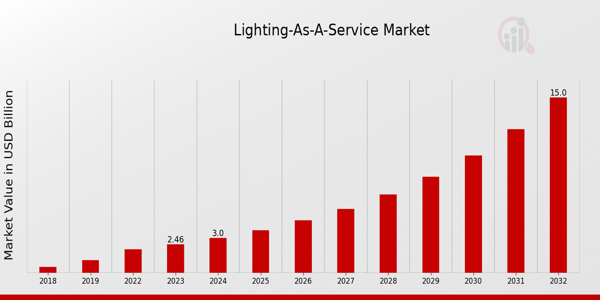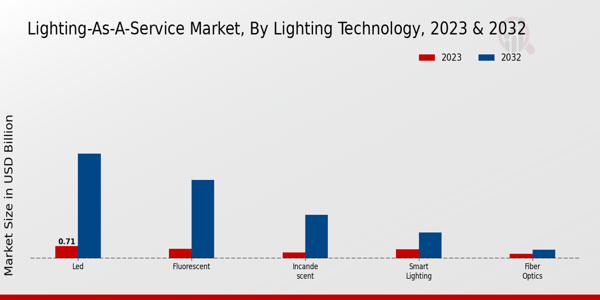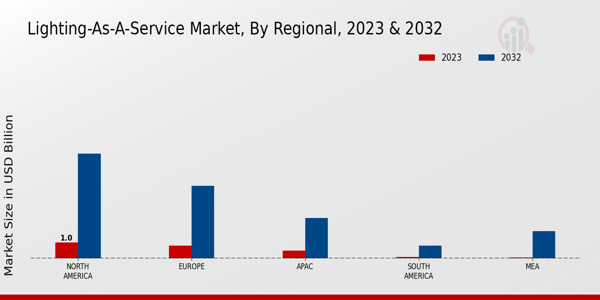Lighting-as-a-Service Market Overview
As per MRFR analysis, the Lighting-as-a-Service Market Size was estimated at 2.01 (USD Billion) in 2022.The Lighting-as-a-Service Market Industry is expected to grow from 2.46 (USD Billion) in 2023 to 15.0 (USD Billion) by 2032. The Lighting-as-a-Service Market CAGR (growth rate) is expected to be around 22.26% during the forecast period (2024 - 2032).
Key Lighting-as-a-Service Market Trends Highlighted
The Global Lighting-as-a-Service market has been experiencing significant growth driven by increasing demand for energy-efficient solutions and a shift towards sustainability. Many businesses are looking to reduce their carbon footprint and operational costs, making flexible and cost-effective lighting solutions attractive. The growing focus on smart technologies and the Internet of Things (IoT) also play a key role, as these innovations enhance the functionality and efficiency of lighting systems. Environmental regulations and building standards are encouraging companies to adopt advanced lighting solutions, further propelling the market. In recent times, there have been numerous opportunities for companies to explore within the Lighting-as-a-Service sector.The marketing perspective seems to be appealing when Smart and Adaptive lighting systems are included. As businesses and cities begin to incorporate electric vehicles into their structures and integrate harnessed electricity systems, there is an accompanying demand for sophisticated lighting systems that will coordinate with all the other intelligent structures. In addition, the continuous spread of metropolitan regions all over the globe pushes the need for extensible lighting systems. The increased understanding of health and well being effects related to lighting stands also as a possible area of growth. Factors such as the increased uptake of LED technology and the growth of the marketplace of subscription services are defining the market.
As organizations seek to upgrade aging infrastructure, the desire for turnkey solutions that provide both hardware and maintenance is becoming more pronounced. Furthermore, the emergence of new business models and financing options is making it easier for companies to invest in advanced lighting systems. Overall, the Lighting-as-a-Service market is evolving rapidly, with a focus on sustainability, innovation, and customer-centric solutions becoming essential components of its future growth trajectory.
Fig 1: Lighting-as-a-Service Market Overview

Source: Primary Research, Secondary Research, MRFR Database and Analyst Review
Lighting-as-a-Service Market Drivers
Increased Focus on Energy Efficiency and Sustainability
One of the primary drivers propelling the Global Lighting-as-a-Service Market Industry is the growing emphasis on energy efficiency and sustainability. As global awareness of climate change rises, businesses and municipalities are increasingly tasked with reducing their carbon footprints and energy consumption. Lighting accounts for a significant portion of electricity use in both residential and commercial settings, leading to a push for solutions that offer more energy-efficient alternatives.Lighting-as-a-Service provides an innovative way to address these concerns by offering customers access to energy-efficient lighting solutions without having to invest a large sum upfront. This operational model allows customers to pay for lighting service on a subscription basis, usually based on energy usage, which aligns well with corporate sustainability goals while also substantially reducing energy costs. Moreover, the use of smart lighting solutions, which can be integrated into the Lighting-as-a-Service framework, enhances energy-efficient operations further by enabling real-time monitoring and controls.This growing momentum towards energy efficiency is not driven solely by regulatory pressures; consumers, notably Millennials and Gen Z, prefer brands that demonstrate a commitment to environmental stewardship. They are more likely to choose businesses that utilize sustainable lighting options, thus encouraging market players to adopt and promote Lighting-as-a-Service models. The dual benefits of reduced energy costs and minimizing environmental impacts are expected to significantly influence the market dynamics and fuel the growth of the Global Lighting-as-a-Service Market in the coming years.
Advancements in Smart Lighting Technology
Technological advancements, particularly in smart lighting, are significantly influencing the growth of the Global Lighting-as-a-Service Market Industry. The integration of IoT (Internet of Things) technology enables lights to communicate with one another and with various user interfaces. This transformation allows for automated lighting controls, personalized settings, and increased energy conservation, attracting more businesses to opt for Lighting-as-a-Service options.Such smart lighting systems offer features like remote monitoring and energy analytics, undeniably enhancing efficiency and providing a higher return on investment.
Cost-Effectiveness and Reduced Capital Expenditure
The cost-effectiveness of Lighting-as-a-Service models is another crucial driver in the Global Lighting-as-a-Service Market Industry. Instead of front-loading costs associated with installation and equipment purchase, businesses can allocate funds towards ongoing service requirements. This financial flexibility is particularly appealing for small and medium-sized enterprises (SMEs) that may not have sufficient capital for upfront investments in advanced lighting systems.As a result, this model continues to attract a wide range of customers across various sectors, fostering market growth.
Lighting-as-a-Service Market Segment Insights
Lighting-as-a-Service Market Lighting Technology Insights
The Global Lighting-as-a-Service Market is witnessing substantial growth within the Lighting Technology segment, which is an essential aspect driving the overall market dynamics. In 2023, this segment is valued at 2.46 USD Billion, with projections showing significant expansion over the following years. The advent of advanced lighting solutions has elevated the industry, with the LED technology holding a majority share. Valued at 0.711 USD Billion in 2023 and expected to grow to 6.0 USD Billion by 2032, LED technology is dominating due to its energy efficiency, long lifespan, and decreasing costs, which provide a compelling value proposition for consumers and businesses alike.Following closely, the Fluorescent lighting segment is valued at 0.569 USD Billion in 2023 and is projected to reach 4.5 USD Billion by 2032. The significance of this segment lies in its widespread use in commercial applications and its comparative affordability, making it a popular choice for organizations looking to reduce overhead costs while maintaining illumination quality. Incandescent lighting, while traditionally popular, is facing a decline, with the current market valuation at 0.355 USD Billion in 2023, expected to grow to 2.5 USD Billion by 2032.This technology's ease of use and warmth in color temperature appeal to some consumers, yet it is gradually superseded by more energy-efficient solutions. The Smart Lighting segment, valued at 0.54 USD Billion in 2023 and expected to rise to 1.5 USD Billion by 2032, reflects a growing trend towards automation and connectivity in lighting systems, appealing to tech-savvy consumers and contributing to energy savings through enhanced control. Fiber Optics, although a smaller player in this market, currently valued at 0.284 USD Billion and anticipated to reach 0.5 USD Billion by 2032, offers unique applications in decorative and specialized lighting solutions, proving their versatility in niche markets.The collective insights from these Lighting Technology segments illustrate how they cater to differing customer demands, enhancing the overall valuation and growth potential of the Global Lighting-as-a-Service Market. This market is propelled by various factors, including the continued shift towards energy efficiency, rising adoption of smart technologies, and the increasing focus on reducing carbon footprints across various industries. Additionally, the burgeoning trends towards sustainable practices and urbanization further expand opportunities within the Lighting Technology landscape, creating a fertile ground for innovation, competition, and enhanced customer choice in the Global Lighting-as-a-Service Market.
Fig 2: Lighting-as-a-Service Market Insights

Source: Primary Research, Secondary Research, MRFR Database and Analyst Review
Lighting-as-a-Service Market Application Insights
The Global Lighting-as-a-Service Market is expected to reach a value of 2.46 USD Billion by 2023, reflecting a growing shift towards innovative lighting solutions across various applications. This market encompasses several essential segments, including Indoor Lighting, Outdoor Lighting, Street Lighting, Architectural Lighting, and Industrial Lighting. Each of these segments plays a crucial role in driving the market forward; for example, Indoor Lighting is pivotal in residential and commercial settings, contributing significantly to energy savings and enhanced user experience.Outdoor Lighting includes essential functionalities for safety and urban aesthetics, while Street Lighting is vital for urban infrastructure and road safety, often seen as a majority holding segment in the lighting landscape. Architectural Lighting is increasingly important for enhancing building aesthetics and energy efficiency, making it significant for both commercial and residential developments. Lastly, Industrial Lighting supports operational efficiency and safety in manufacturing environments, further emphasizing its importance in the Global Lighting-as-a-Service Market.Overall, these segments not only showcase the diverse applicability of lighting services but also contribute substantially to market growth, indicating a robust future driven by enhanced energy efficiency and sustainability trends.
Lighting-as-a-Service Market End Use Insights
The Global Lighting-as-a-Service Market is experiencing substantial growth across various end-use sectors, playing a pivotal role in the transformation of lighting solutions from traditional systems to innovative, service-oriented models. In 2023, the market was valued at 2.46 billion USD, reflecting a robust demand for energy-efficient lighting solutions. The residential sector has significantly contributed to this growth as homeowners increasingly seek smart lighting solutions to enhance energy management and reduce costs. The commercial segment also showcases strong market potential, driven by businesses looking to lower operational expenses and improve sustainability through smart lighting technologies.Industrial applications emphasize the importance of high-performance lighting in enhancing productivity while minimizing energy consumption. The institutional sector, including educational and healthcare facilities, has adopted Lighting-as-a-Service to create improved environments that meet regulatory standards and enhance user experience. Overall, the segmentation of the Global Lighting-as-a-Service Market highlights a diverse landscape where each end-use application is vital for promoting sustainable lighting practices and aligning with current market trends, driven by the need for energy efficiency and cost-effectiveness.
Lighting-as-a-Service Market Service Type Insights
The Global Lighting-as-a-Service Market, valued at 2.46 USD billion in 2023, is evolving significantly within the Service Type segmentation, including Installation, Maintenance, Monitoring, and Upgradation. Each service type plays a vital role in shaping the market dynamics and enhancing customer experience. Installation services are crucial as they facilitate the seamless setup of lighting systems tailored to specific needs, while Maintenance ensures the longevity and optimal performance of these systems, representing a significant portion of recurring revenue.Monitoring services are increasingly important in providing real-time data analytics, contributing to energy efficiency and overall performance. Upgradation is also prominent, as businesses seek to stay ahead with the latest lighting technologies and sustainability practices. The Global Lighting-as-a-Service Market statistics reflect a robust growth trajectory driven by advancements in smart lighting solutions and increasing demand for energy efficiency. The market growth is further supported by trends toward sustainable infrastructure and smart city initiatives, offering significant opportunities for service providers in this sector.
Lighting-as-a-Service Market Regional Insights
The Global Lighting-as-a-Service Market, valued at approximately 2.46 USD Billion in 2023, is projected to experience significant growth, reaching 15.0 USD Billion by 2032. In the Regional analysis, North America leads the market with a valuation of 1.0 USD Billion in 2023, growing robustly to 6.5 USD Billion in 2032, reflecting its majority holding due to industrial advancements and sustainability initiatives. Europe follows closely, valued at 0.8 USD Billion in 2023 and expanding to 4.5 USD Billion by 2032, driven by regulatory support for energy efficiency.The Asia-Pacific region, valued at 0.5 USD Billion in 2023, is also expected to experience substantial growth, reaching 2.5 USD Billion by 2032, largely due to rapid urbanization and development activities. South America and Middle East Africa represent smaller segments but show promising signs; South America starts at 0.1 USD Billion in 2023 and grows to 0.8 USD Billion by 2032, while MEA progresses from 0.06 USD Billion in 2023 to around 1.7 USD Billion in 2032, indicating rising interest in sustainable solutions. Overall, the Global Lighting-as-a-Service Market segmentation showcases diverse opportunities and challenges across these regions, highlighting the importance of tailored strategies for market growth.
Fig 3: Lighting-as-a-Service Market Regional Insights

Source: Primary Research, Secondary Research, MRFR Database and Analyst Review
Lighting-as-a-Service Market Key Players and Competitive Insights
The Global Lighting-as-a-Service Market is gaining traction as organizations increasingly focus on energy efficiency, cost reduction, and sustainable lighting solutions. This innovative approach allows businesses to access lighting technologies and services without the upfront capital costs typically associated with traditional lighting installations. The competitive landscape is characterized by a growing number of players that are adapting to emerging trends, including the integration of smart lighting technologies, advancements in LED lighting, and increased emphasis on sustainability. As environmental concerns become more prevalent and customers seek innovative financing models, competition in this market is intensifying, prompting companies to differentiate themselves through service offerings, technological advancements, and strategic partnerships.Osram stands out in the Global Lighting-as-a-Service Market due to its robust portfolio of innovative lighting solutions that emphasize quality, efficiency, and sustainability. The company leverages its extensive expertise in semiconductor technology and smart lighting to provide tailored solutions to customers, enhancing their operational efficiency and reducing energy consumption. Osram's comprehensive service offerings, including real-time monitoring and maintenance, allow clients to optimize their lighting systems while maintaining high levels of performance. Furthermore, Osram’s emphasis on sustainability and commitment to reducing the environmental impact of its products amplify its market presence. The scalability of its services enables the company to cater to various sectors, including commercial, industrial, and public spaces, reinforcing its competitive edge in the flourishing Lighting-as-a-Service landscape.Acuity Brands is another key player in the Global Lighting-as-a-Service Market, distinguished by its extensive range of intelligent lighting and building management solutions. The company’s strong focus on innovation allows it to offer customers an integrated approach, combining energy-efficient lighting systems with advanced controls and data analytics. Acuity Brands places great importance on customer experience, providing customizable services that cater to different client needs and preferences. The company's commitment to designing and delivering cutting-edge lighting solutions helps it maintain a significant advantage in a marketplace increasingly characterized by competition. Additionally, Acuity Brands' growing emphasis on IoT and smart city initiatives positions it to effectively address the evolving demands of the market, thereby ensuring its ongoing relevance and leadership in the Lighting-as-a-Service sector.
Key Companies in the Lighting-as-a-Service Market Include
-
Osram
-
Acuity Brands
-
Sylvania
-
Signify
-
Philips
-
Johnson Controls
-
Cree
-
Schneider Electric
-
Honeywell
-
Zumtobel
-
GE Current
-
Digital Lumens
-
Lutron Electronics
-
Eaton
-
Legrand
Lighting-as-a-Service Market Industry Developments
The Global Lighting-as-a-Service Market has witnessed significant developments recently, particularly in the context of leading companies such as Signify, Philips, and Acuity Brands, which are expanding their service offerings to enhance energy efficiency and sustainability. Emerging trends indicate a growing emphasis on smart lighting solutions integrated with IoT technology, driving further innovation in the sector. Noteworthy movements include mergers and acquisitions, with Osram acquiring a smaller tech company to strengthen its position in the smart lighting market, aligning with the increasing demand for integrated solutions. Additionally, Honeywell and Schneider Electric are collaborating on various projects that enhance their Lighting-as-a-Service capabilities, leveraging their expertise in building management systems. Companies like Cree and GE Current are also focusing on developing energy-efficient lighting technologies, contributing to a projected growth in the market valuation as organizations recognize the financial and environmental benefits of Lighting-as-a-Service. This shift is expected to have a profound impact on industry dynamics as firms prioritize sustainable practices and smart solutions to meet evolving customer demands in the global market landscape.
Lighting-as-a-Service Market Segmentation Insights
Lighting-as-a-Service Market Lighting Technology Outlook
- LED
- Fluorescent
- Incandescent
- Smart Lighting
- Fiber Optics
Lighting-as-a-Service Market Application Outlook
- Indoor Lighting
- Outdoor Lighting
- Street Lighting
- Architectural Lighting
- Industrial Lighting
Lighting-as-a-Service Market End Use Outlook
- Residential
- Commercial
- Industrial
- Institutional
Lighting-as-a-Service Market Service Type Outlook
- Installation
- Maintenance
- Monitoring
- Upgradation
Lighting-as-a-Service Market Regional Outlook
- North America
- Europe
- South America
- Asia Pacific
- Middle East and Africa
|
Report Attribute/Metric
|
Details
|
|
Market Size 2022
|
2.01 (USD Billion)
|
|
Market Size 2023
|
2.46 (USD Billion)
|
|
Market Size 2032
|
15.0 (USD Billion)
|
|
Compound Annual Growth Rate (CAGR)
|
22.26% (2024 - 2032)
|
|
Report Coverage
|
Revenue Forecast, Competitive Landscape, Growth Factors, and Trends
|
|
Base Year
|
2023
|
|
Market Forecast Period
|
2024 - 2032
|
|
Historical Data
|
2019 - 2023
|
|
Market Forecast Units
|
USD Billion
|
|
Key Companies Profiled
|
Osram, Acuity Brands, Sylvania, Signify, Philips, Johnson Controls, Cree, Schneider Electric, Honeywell, Zumtobel, GE Current, Digital Lumens, Lutron Electronics, Eaton, Legrand
|
|
Segments Covered
|
Lighting Technology, Application, End Use, Service Type, Regional
|
|
Key Market Opportunities
|
Smart city initiatives, Energy efficiency regulations, Sustainability-focused investments, IoT integration for lighting, Retrofitting aging infrastructure
|
|
Key Market Dynamics
|
Energy efficiency improvements, Cost savings potential, Smart lighting integration, Environmental sustainability focus, Government incentives and regulations
|
|
Countries Covered
|
North America, Europe, APAC, South America, MEA
|
Lighting-as-a-Service Market Highlights:
Frequently Asked Questions (FAQ) :
The Global Lighting-as-a-Service Market is expected to be valued at 15.0 USD Billion in 2032.
The projected CAGR for the Global Lighting-as-a-Service Market from 2024 to 2032 is 22.26%.
North America is expected to hold the largest market share, valued at 6.5 USD Billion in 2032.
The market in Europe is projected to grow to 4.5 USD Billion by 2032.
The market for LED technology in the Global Lighting-as-a-Service Market is expected to reach 6.0 USD Billion in 2032.
Key players in the market include Osram, Acuity Brands, Sylvania, Signify, and Philips.
Smart Lighting technology is anticipated to have a market size of 1.5 USD Billion in 2032.
The Fluorescent technology segment is expected to be valued at 4.5 USD Billion by 2032.
The Asia-Pacific region is projected to be worth 2.5 USD Billion by 2032.
Growth opportunities in the market arise from advancements in lighting technology and increasing demand for energy efficiency.


















